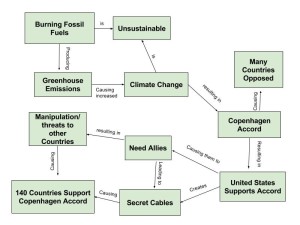2. My diagram starts off with the burning of fossil fuels which is the key contributor to climate change. I showed how fossil fuels create greenhouse emissions which lead to climate warming and ultimately a transformation in climate. Since climate change is the single most important issue in civilization today, an agreement needed to be made to mitigate greenhouse gas emissions on a global scale. Subsequently, I showed how the UN Climate Change Conference created the Copenhagen Accord. Many countries that were involved in the climate change initiative were initially not in favor of this political agreement. The accord could not guarantee the global greenhouse gas cuts needed to prevent dangerous warming from occurring. The Accord also threatens to bypass the UN’s Kyoto protocol, in which many rich nations have liability. Due to these reasons, many of the most vulnerable and poorest countries were not in favor of the accord. However, the United States supported the agreement. I created an arrow pointing from the United States to Needs Allies because the United States benefited from this agreement. They wanted to gain allies for a majority vote. In order to gain allies they manipulated countries that didn’t have a large carbon footprint, with financial aid. Many of these countries are impoverished and agreed to the accord just because they were in need of financial assistance. The United States also threatened countries with various ultimatums and secret cables for spying purposes.They mounted a secret global diplomatic offense to overwhelm opposition. Furthermore, the United States persuaded and encouraged 140 different countries to support the Copenhagen Accord.
3. Although it is extremely difficult to negotiate a climate treaty to reduce greenhouse emissions, I believe the way the United States gained allies for the Copenhagen Accord was unethical. There are better ways to handle the situation. Sending the secret cables was an invasion of privacy to the other countries. I also do not like the fact the US threatened innocent countries for selfish reasons. Although our method was effective, I believe there are more ethical means to handle this situation. I strongly believe the Copenhagen Accord could be very beneficial on a global scale. It is steering countries in the right direction of mitigation which will ultimately reduce greenhouse emissions. Nevertheless, I do believe other countries should have the right to decide whether they oppose or support an agreement. I also felt like it was very dishonorable for the United States to use aid to gain political backing. Brazil’s vice-environment minister stated that the United States could advertise its new commitment to bettering climate change by contributing to the Amazon Fund. Instead of contributing, we basically decided to use subversion and manipulate the country to agree to the document. Donating to different causes is just one of the many ways we are capable of getting our voice heard. Using our money to threaten and manipulate is not an ethical option to climate diplomacy. The United States could have also created a presentation or document about mitigation and sent it to the other countries. I believe disclosing the numerous social and environmental benefits of the the Copenhagen accord could ultimately convince others to collectively re-engineer the global economy.


Tawnya,
I like your ethical analysis of this situation. I agree that many of the players in this situation acted without honor or concern for the other nations involved in these negotiations. You end your post on an optimistic note,both in terms of mitigation of climate change and the possibility of future agreements. I hope these thoughts become reality.
Thank you for an interesting post.
Mike
You may find my post at: https://wp.me/p3RCAy-dVg
Hi! My name is Chris. Here is the link to my blog if you want to check it out.
http://geog030.dutton.psu.edu/2016/04/07/53447/
Our two diagrams are pretty similar. They both start with the emission of greenhouse gases and then show how that relates to the issue of leaking cables that we read in the module. I also questioned the United States ethics while dealing with this whole issue. I know it is a very complicated issue, but I agree that the US could have dealt with it in a slightly different way. I think having the US create a presentation would have been a much better idea, and it would have been much more ethical. Th plan was a good one, so just presenting the facts should have been enough for countries to offer their support for it. Great post!